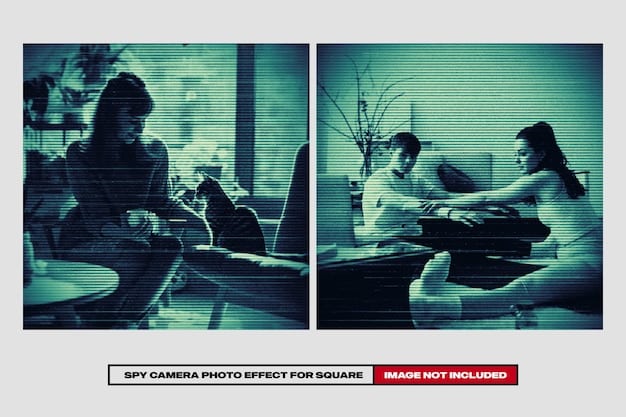Is Dubbing Dead? Subtitles vs. Dubbing in US Film Distribution

The debate around subtitles versus dubbing in the US distribution of international films centers on accessibility, artistic integrity, and viewer preference, with opinions varying on whether dubbing enhances or detracts from the original cinematic experience.
The prevalence of streaming services has opened up a world of international cinema to US audiences, sparking a renewed debate: is dubbing dead? Exploring the debate around subtitles vs. dubbing in US distribution of international films is crucial as it impacts how viewers engage with foreign films.
The Rise of International Cinema in the US
The American film market has historically been dominated by domestic productions, but the streaming era has ushered in a new wave of interest in international cinema. Platforms like Netflix, Amazon Prime Video, and Hulu offer vast libraries of foreign films and TV shows, exposing US audiences to diverse cultures and cinematic styles.
Streaming Services and Global Content
Streaming services have played a pivotal role in popularizing international cinema. With easy access to a wide range of foreign titles, viewers are now more likely to explore content beyond Hollywood blockbusters. This shift has created a demand for subtitled and dubbed versions of these films, leading to ongoing debates about which method provides a superior viewing experience.
Changing Attitudes Towards Foreign Films
As exposure to international cinema increases, attitudes toward foreign films are changing. US audiences are becoming more accepting of subtitles, recognizing them as a legitimate way to experience a film in its original form. However, the debate over subtitles versus dubbing remains, particularly among those who find subtitles distracting or prefer a more immersive viewing experience.

- Increased availability on streaming platforms
- Growing acceptance of subtitles among US audiences
- Demand for diverse content beyond Hollywood
The growing popularity of international cinema in the US has created both opportunities and challenges for distributors. While streaming services have made foreign films more accessible, the debate over subtitles versus dubbing continues to influence how these films are presented to and received by American audiences.
The Case for Subtitles: Authenticity and Original Performance
Subtitles have long been the preferred method for many cinephiles when watching international films. Proponents argue that subtitles offer a more authentic viewing experience, preserving the original performances and artistic intent of the filmmakers. By presenting the film in its original language, subtitles allow viewers to appreciate the nuances of the dialogue, the actors’ vocal inflections, and the cultural context of the story.
Preserving Original Performances
One of the main arguments in favor of subtitles is that they preserve the original performances of the actors. Dubbing, on the other hand, replaces the actors’ voices with those of voice actors, which can alter the emotional impact and authenticity of the performance. Subtitles allow viewers to hear the actors’ original voices, capturing the subtle nuances and emotional depth of their performances.
Understanding Cultural Nuances
Subtitles can also help viewers understand the cultural nuances of a film. Language is deeply intertwined with culture, and subtitles can provide insights into cultural references, idioms, and social customs that might be lost in translation. By preserving the original language, subtitles offer a more immersive and culturally enriching viewing experience.
Subtitles as a Learning Tool
For some viewers, subtitles can also be a valuable learning tool. Watching films with subtitles can help improve language skills, expand vocabulary, and develop a better understanding of different cultures. Subtitles can also make foreign films more accessible to viewers who are deaf or hard of hearing, allowing them to enjoy these films without relying on dubbing.
- Preserves original vocal performances and emotions
- Offers insights into cultural nuances and language
- Serves as a learning tool for language acquisition
The case for subtitles highlights the importance of authenticity and cultural understanding in the viewing experience. By preserving the original performances and cultural context of a film, subtitles offer a more immersive and enriching experience for viewers who value these aspects of cinema.
The Appeal of Dubbing: Accessibility and Immersive Viewing
While subtitles are favored by many, dubbing offers its own set of advantages, particularly in terms of accessibility and immersion. Dubbing replaces the original dialogue with a translated version, allowing viewers to focus on the visuals without having to read subtitles. This can be especially appealing to viewers who find subtitles distracting or difficult to follow, or who prefer a more immersive viewing experience.
Removing the Reading Barrier
One of the main benefits of dubbing is that it removes the reading barrier, making international films more accessible to a wider audience. Some viewers find subtitles distracting, as they require constant attention and can take away from the visual experience. Dubbing allows viewers to focus solely on the images and action, providing a more seamless and immersive viewing experience.
Targeting Specific Demographics
Dubbing can also be useful for targeting specific demographics, such as children or elderly viewers who may have difficulty reading subtitles. By providing a dubbed version, distributors can make international films more accessible to these groups, expanding the potential audience for these films.
Enhancing Immersion and Engagement
For some viewers, dubbing can enhance immersion and engagement by eliminating the need to read subtitles. Without having to focus on the text, viewers can fully immerse themselves in the story and connect with the characters on a deeper level. This can be particularly appealing for viewers who want to relax and enjoy a film without having to exert extra mental effort.

- Eliminates the need to read subtitles, enhancing immersion
- Makes international films more accessible to wider audiences
- Targets specific demographics like children and the elderly
The appeal of dubbing lies in its ability to make international films more accessible and immersive for a wider audience. By removing the reading barrier and allowing viewers to focus on the visuals, dubbing can enhance the viewing experience for those who find subtitles distracting or prefer a more seamless presentation.
The Evolution of Dubbing Quality
Dubbing has historically been criticized for its poor quality, with many viewers finding dubbed versions of films to be unnatural and unconvincing. However, dubbing technology and techniques have improved significantly in recent years, leading to a noticeable increase in the quality of dubbed content. Modern dubbing aims to closely match the original performances, capturing the emotions and nuances of the original actors.
Advancements in Technology and Techniques
Advancements in technology have played a crucial role in improving the quality of dubbing. Sophisticated software and equipment allow voice actors to synchronize their performances more closely with the original actors’ lip movements, creating a more natural and convincing effect. Techniques like ADR (Automated Dialogue Replacement) have also become more refined, allowing for better integration of dubbed dialogue into the film.
Lip-Syncing and Voice Acting
Effective lip-syncing is essential for creating a believable dubbed version of a film. Voice actors must carefully match their lip movements to those of the original actors, ensuring that the dialogue appears natural and synchronized. Skilled voice actors can also capture the emotions and nuances of the original performances, adding depth and authenticity to the dubbed version.
The Impact of Streaming Services
Streaming services have contributed to the improvement of dubbing quality by investing in high-quality dubbing for their international content. These platforms recognize the importance of providing accessible and engaging viewing experiences for their global audiences, and they have invested in the technology and talent needed to create high-quality dubbed versions of their films and TV shows.
The evolution of dubbing quality has been driven by technological advancements, improved techniques, and increased investment from streaming services. As dubbing quality continues to improve, it is becoming an increasingly viable option for viewers who prefer not to read subtitles.
US Market Trends: Subtitles vs. Dubbing Preferences
In the US market, the debate over subtitles versus dubbing is influenced by a variety of factors, including cultural attitudes, viewing habits, and personal preferences. While subtitles have traditionally been favored by cinephiles and art-house audiences, dubbing is gaining popularity among mainstream viewers and those who prioritize accessibility and immersion.
Cultural Attitudes and Historical Context
Cultural attitudes toward foreign films play a significant role in shaping preferences for subtitles versus dubbing. Historically, the US market has been less receptive to foreign films compared to other countries, and subtitles have been seen as a barrier to entry for many viewers. However, as exposure to international cinema increases, attitudes are changing, and more viewers are becoming open to watching films with subtitles.
Viewing Habits and Accessibility
Viewing habits also influence preferences for subtitles versus dubbing. Viewers who are accustomed to watching films in their original language with subtitles may find dubbing to be distracting or unnatural. On the other hand, viewers who prefer a more passive viewing experience may find dubbing to be more convenient and enjoyable.
Personal Preferences and Demographics
Personal preferences and demographics also play a role in shaping preferences for subtitles versus dubbing. Younger viewers, who have grown up with streaming services and international content, may be more open to watching films with subtitles. Older viewers, or those who have difficulty reading subtitles, may prefer dubbed versions of films.
| Key Point | Brief Description |
|---|---|
| 🎬 Subtitle Authenticity | Preserves original performance and cultural nuances. |
| 🎧 Dubbing Accessibility | Removes reading barrier and targets wider audience. |
| 🔊 Dubbing Quality | Improved technology enhances dubbing believability. |
| 📊 US Market Trends | Growing acceptance of both subtitles and dubbing among US viewers. |
Frequently Asked Questions
▼
Subtitles preserve original performances, including vocal inflections, and offer insight into the cultural context of the film, allowing viewers to appreciate nuances that may be lost in translation.
▼
Dubbing eliminates the need to read subtitles, making films more accessible and providing a more immersive viewing experience by allowing viewers to focus solely on the visuals.
▼
Dubbing quality has improved with advancements in technology, such as better lip-syncing software, skilled voice acting, and the use of Automated Dialogue Replacement (ADR) techniques.
▼
Streaming services have increased the availability of both subtitled and dubbed versions of international films, catering to different viewer preferences and investing in high-quality dubbing.
▼
Yes, as exposure to international cinema increases, attitudes are evolving. While subtitles have traditionally been preferred by cinephiles, dubbing is gaining popularity among mainstream audiences.
Conclusion
The debate between subtitles and dubbing in the US distribution of international films is complex and multifaceted. Ultimately, the choice between subtitles and dubbing comes down to personal preference, with each method offering its own unique set of advantages. As the quality of dubbing continues to improve and attitudes toward international cinema evolve, both subtitles and dubbing will likely continue to play important roles in making foreign films accessible to US audiences.





